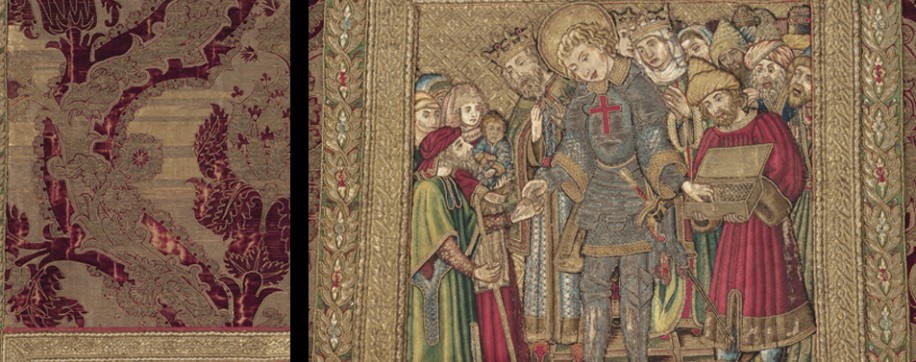Catalunya 1400
The International Gothic Style
A secret embroidered in gold

Antoni Sadurní and Workshop (embroidery); Bernat Martorell (pictorial model)
Dalmatic from the Saint George vestments, c. 1445-1450.
Barcelona, Palau de la Generalitat de Catalunya
capella de Sant Jordi
© Museu Nacional d’Art de Catalunya.
Fotògrafs: Calveras/Mérida/Sagristà
The flourishing art of embroidery in Barcelona
The dalmatic of the Sant Jordi set of liturgical vestments, which is of extraordinary beauty, both in its making and in its design, is an example of the extremely high level of technical skill Barcelona’s embroidery workshops reached in the 15th century.
This sumptuary art was held in great consideration by the society, even more so than altarpiece painting, and was obviously connected with the wish of the elites to gain favour through the purchase of exquisite works of art.
The dalmatic of the Sant Jordi liturgical vestments
A dalmatic is a piece of clothing with wide sleeves that was worn over the alb by the deacon and subdeacon during ceremonies. The Sant Jordi dalmatic was part of a set consisting of four items, a chasuble, two dalmatics and a cope. This set and an altar frontal were commissioned for the chapel of the Palau de la Generalitat in Barcelona and both were dedicated to Saint George. Because of the lack of documentation on the authorship of the vestments, and the alterations made to them over the space of two centuries, they and the altar frontal were interpreted as being independent works. However, the two were conceived as a single unit, following the same picture scheme, and show the same workmanship.
The set has 17 scenes and is one of the most ambitious cycles devoted to Saint George in the Crown of Aragon. The narrative begins on the frontal, where the saint fights the dragon to free the princess, exactly the same scene that occupied the main compartment of the chapel retable. The vestments, for their part, like the side columns of the retable, include the story of the saint’s martyrdom. The image of the priests dressed in these embroidered robes celebrating mass before the altar where the frontal was hung must therefore have brought to mind a retable in movement.
The secret embroidered in gold
The Sant Jordi altar frontal and vestments were made from the finest materials, such as red Venetian velvet, and embroidered with gold, silver and silk thread. The figures, the architectural backgrounds and the landscapes were made using a technique known as ‘needle painting’, in which meticulous stitching is used to imitate the effects and the finish of painting. This is why these workshops required the work of master painters who made the preliminary cartoons that were used as a model for the embroidery.
It was important to find out who was behind this extraordinary work. According to a document in the archives of the Generalitat, the embroiderer Antoni Sadurní had been given the job of making an altar frontal for the Generalitat chapel in 1450. One year later the work was finished. The speed of execution vouches for the importance and the prosperity of the master embroiderer, who was originally from Montblanc and a belonged to a family who specialised in this trade.
The most prosperous workshops had partners who were experts in the different trades: painters, silversmiths and embroiderers who all contributed to satisfying the most demanding commissions. The design for such a special job as this called for the best artist of all, Bernat Martorell. A master of large altarpieces as well as a miniaturist, he also provided pictorial models for the embroidery of liturgical vestments and for stained-glass windows. The master’s hand seems unmistakable in the model for this embroidery if we compare the Sant Jordi altar frontal and liturgical vestments with one of the artist’s greatest works, the retable of Saint George he painted some years before.
| Artist | Antoni Sadurní and Workshop (embroidery); Bernat Martorell (pictorial model) |
|---|---|
| Title | Dalmatic from the Saint George vestments |
| Date | c. 1445-1450 |
| General | Embroidery |
| Material / Tecnique | Embroidery, gold, metallic and silk thread |
| Dimensions | 118 cm |
| Work conserveted in | Barcelona, Palau de la Generalitat, capella de Sant Jordi |
